The NVIDIA GeForce GTX 650 Ti Review, Feat. Gigabyte, Zotac, & EVGA
by Ryan Smith on October 9, 2012 9:00 AM ESTOverclocking: Power, Temperature, & Noise
Our final task is our look at the overclocking capabilities of our GTX 650 Ti cards.
Because the GTX 650 Ti is based on a lower clocked GK106 we should have more headroom to play with. Furthermore because GPU Boost is not present, and hence NVIDIA is not min-maxing GPU clockspeeds in the first place, there should be even more headroom to play with. For overclockers dissatisfied with overclocking in the world of GPU Boost, the GTX 650 Ti is going to be a return to old fashioned overclocking.
As an added benefit, because GPU Boost is not present NVIDIA is not operating these cards so close to their 1.175v limit. While it’s true the 1.175v limit is still in place, with the average shipping voltage being nearly 0.1v below that limit there’s some overvolting headroom to play with that GeForce 600 cards don’t typically get to experience.
| GeForce GTX 650 Ti Overclocking | ||||||
| Ref GTX 650 Ti | EVGA GTX 650 Ti SSC | Zotac GTX 650 Ti AMP | Gigabyte GTX 650 Ti OC | |||
| Shipping Core Clock | 925MHz | 1071Mhz | 1033MHz | 1033MHz | ||
| Shipping Memory Clock | 5.4GHz | 5.4GHz | 6.2GHz | 5.4GHz | ||
| Shipping Load Voltage | 1.087v | 1.05v | 1.087v | 1.087v | ||
| Overclock Core Clock | 1175MHz | 1175MHz | 1175MHz | 1175MHz | ||
| Overclock Memory Clock | 6.6GHz | 6.6GHz | 6.6GHz | 6.6GHz | ||
| Overclock Load Voltage | 1.162v | 1.15v | 1.162v | 1.162v | ||
When we’re looking at cards similar to a reference design it’s not unusual for those cards to top out at similar clockspeeds. It’s not even rare to have two cards top out at the same spot. But it’s highly unusual to have all 4 cards top out at the same point: 1175MHz core and 6.6GHz memory. Despite our best efforts each and every card would fail 1200/6.7 at some point, forcing us back down to the clockspeeds you see above. Perhaps what is most interesting is that none of the factory overclocked cards managed to push higher than our reference card, or even higher than one-another for that matter. Given what we’re seeing it looks like GK106 is naturally capable of 1050MHz+ clockspeeds, so the amount of failed chips coming out of factory overclock binning should be minimal.
Oddities aside, these overclocks are quite good. Compared to the reference GTX 650 these clocks represent a 250MHz (27%) core overclock coupled with a 1.2GHz (22%) memory overclock. These are far greater overclocks than what we’ve seen on any other GeForce 600 series card to date, once again thanks to the fact that the GTX 650 Ti’s clockspeeds are so low due in large part to a lack of GPU Boost. Budget overclockers will almost certainly be quite pleased with the GTX 650 Ti, though it’s worth noting that its closest competition is the similarly overclocking-friendly 7850.
Moving on to our performance charts, we’re going to once again start with power, temperature, and noise, before moving on to gaming performance.
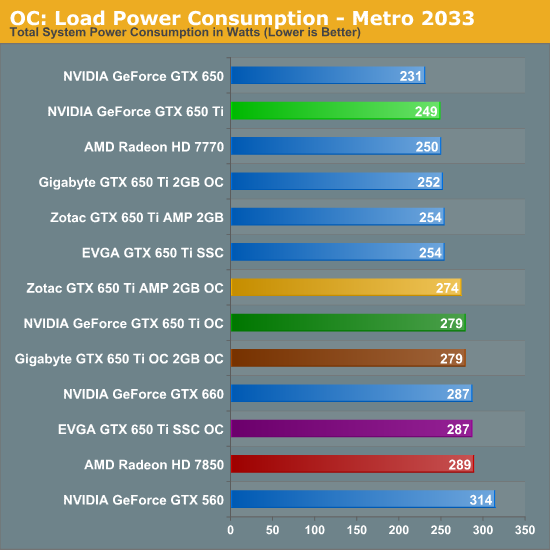
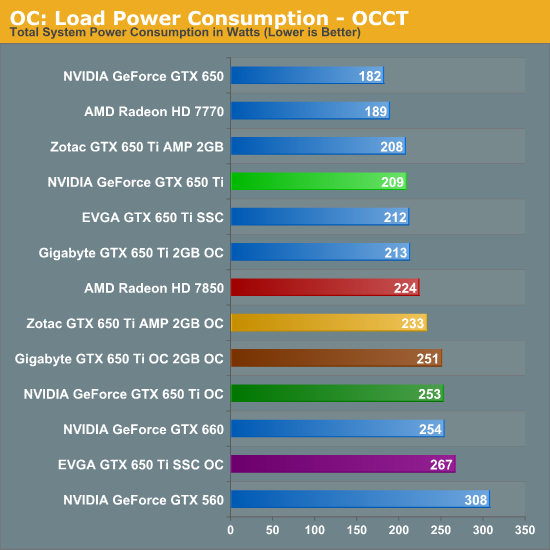
Unlike overclocking cards with GPU Boost, in the case of the GTX 650 Ti we are unquestionably overvolting the card. As a result the power consumption penalty for overclocking is quite harsh on a relative basis, though thankfully the GTX 650 Ti starts out low enough that the PCBs and the coolers are having no problem keeping up.
Overall, our overclocking efforts have pushed the power consumption of our GTX 650 Ti cards up by 30-40W, which puts power consumption just below the GTX 660 and 7850. The best performing card in this regard – that is, the card with the smallest increase in power consumption – is the Zotac card, followed by the close pairing of the Gigabyte card and the reference card, and finally EVGA’s card. This is one of those cases where a sample size of 1 just isn’t big enough, so there’s no clear reason why Zotac does so well or EVGA fares so poorly. Looking at temperatures it may be that we’re seeing temperature induced leakage, then again it may be that the hottest card is the hottest because of that power consumption.
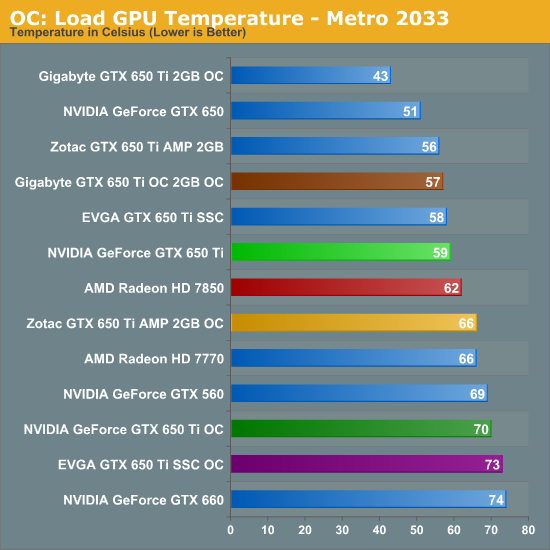
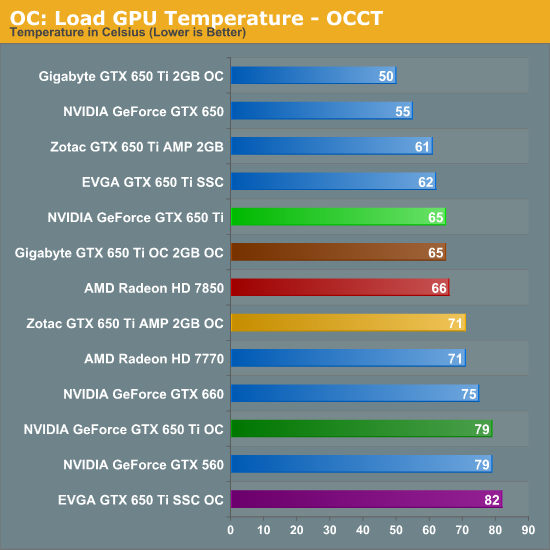
Next up is load temperatures. As we’ve already seen in our look at stock performance the Gigabyte card has a relatively aggressive fan curve, which is great for temperatures at the cost of noise. As a result even in the worst case scenario of OCCT it only hits 65C, 6C cooler than the next-closest overclocked card. That brings us to the Zotac card, which isn’t as cool as Gigabyte’s card but at 71C is still doing rather well. This is followed by the reference card at 79C, and finally the EVGA card at 82C.
Given the amount of power we’re channeling through these cards, it’s rather surprising just how well they hold up here. Even with these small coolers GPU temperatures are well into the safe zone, though the EVGA card is about as hot as we’d let such a card get under normal circumstances.
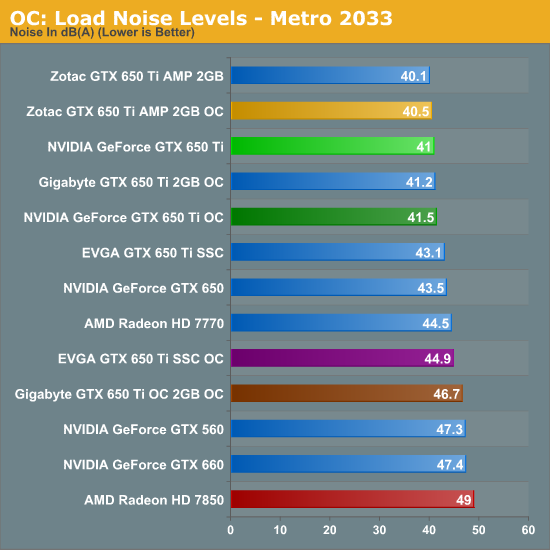
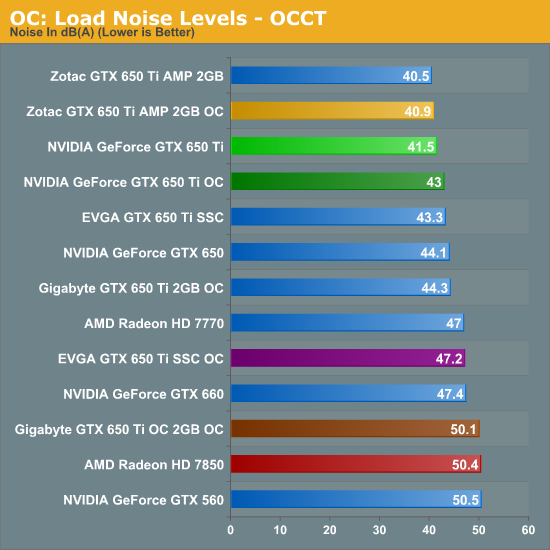
Moving on to noise, the cards that were previously doing well with stock settings continue to do well, while the rest of the cards fall further behind the leaders. The quietest card remains the Zotac, which even overvolted and running OCCT still doesn’t pass 41dB(A), which is simply incredible given the amount of power it’s pulling by this point. And as we’ve already seen its temperatures are respectable too, so Zotac seems to have hit the perfect balance here.
At the other end of the spectrum we have the EVGA and Gigabyte cards. Gigabyte continues to fall behind due to their aggressive fan curve, while the EVGA card and its poor overclocked temperatures require the card to push the fan even harder to keep up. Neither one of these cards is doing an acceptable job in light of what the Zotac card nor the reference card are achieving.










91 Comments
View All Comments
CeriseCogburn - Friday, October 12, 2012 - link
Oh there's the amd fanboy bloviating spew I predicted above you responded to ! LOL I cannot frikkin believe it, I got it exactly correct without looking ! Here I will FTFamd fanboy" Don't forget, the 650Ti comes with a game and so does the 560Ti. Coming with a game is necessary just to compete right now. The 460 also has some highly factory overclocked models that can smash out the 7770 while still being cheaper. The 7850 would do better at $10 or $20 lower and a MIR is a great way to accomplish that since a lot of people forget to do them anyway, but buy the card because of the after MIR price. ( I love ripoff MIR because I am an idiot shining on for corpo pig profits I hate so much).
ionis - Wednesday, October 10, 2012 - link
2 of the 17 2GB 7850s on newegg comes with a game. I didn't bother checking the 1GB, b/c who cares about the 1GB? To say they comes with a game is a bit disingenuous.CeriseCogburn - Friday, October 12, 2012 - link
It's okay all the amd fanboys can get the lowest low down 1GB now at the cited lowdown more expensive price, that doesn't matter when they are making their arguments for amd fanboyism.Two seconds later they will be screaming the 7850 is future proof with 2g ram so F orget the 650Ti, it is also the best deal againbecause amd roxxors.
So 1gb price, and magically in the deranged gourd of the amd fanboy 2G card is futureproof.
That is the amd fanboy brain after it exited the blender 20 years ago.
Galidou - Saturday, October 13, 2012 - link
The 7850 is a better choice for one freaking big reason you Cerise wouldn't be able to see because you're blinded with green glasses. When you buy a 7850 you always have the choice to go crossfire in the future which is something that happens often in the enthusiast world.Usually GTX is branded for the enthusiast market and reffered as the better cards from Nvidia but hey, where is my SLI connector? Oh... there's none... they had to cut it for cost purposes, that's what Nvidia claims..... First time in history a GTX card comes without one... you're so stubborn you can't even see any downside when they're OBVIOUS..... HELL even half of the radeon 7770 comes with Crossfire support and some of them costs 120$...
nathanddrews - Tuesday, October 9, 2012 - link
I see what you did there...Denithor - Tuesday, October 9, 2012 - link
I caught that too. Thought it was cute but kinda silly.Wonder how much of the target audience got it?
Exodite - Tuesday, October 9, 2012 - link
I'd wager most of the AT readers passed middle school chemistry. :PPaulman - Wednesday, October 10, 2012 - link
Exodite is right. Also, nerds love memorizing trivia (and the periodic table definitely counts).CeriseCogburn - Friday, October 12, 2012 - link
I'll wager if that's minimally true we've got a dumber group than the general populace.Since the idiots group think yours was a great line, the above may in fact be the case.
chizow - Tuesday, October 9, 2012 - link
As indicated in the review, the 650Ti fills the huge gap in performance between the 7850/GTX 660 and 7770/GTX 650, its price just needs to be adjusted in light of AMD's pre-emptive cuts on the 7850. Once we start seeing ~$20 rebates similar to those we see for the 7850, the 650Ti should be a more appealing option in the sub-$150 range.I also think Nvidia missed an opportunity here by turning off Boost for sub-660 parts. It's just inconsistent with the rest of the Kepler line and while it allows partners to benefit on OC parts, they are clearly charging an additional premium instead of offering it at MSRP like past parts such as EVGA FPB.
Most interesting to me seeing how these bandwidth neutered parts perform is how shading/backend performance has caught up and is generally no longer the biggest bottleneck; bandwidth tends to hold these cards back more often than not compared to their bigger siblings even at modest resolutions like 1080p.